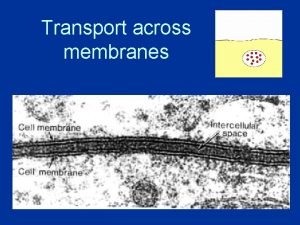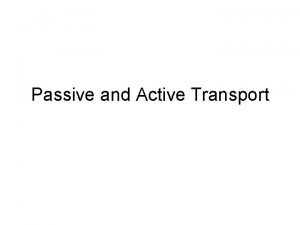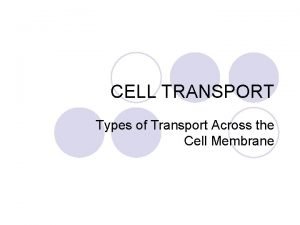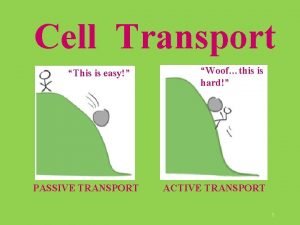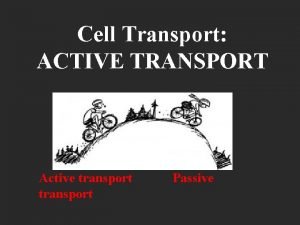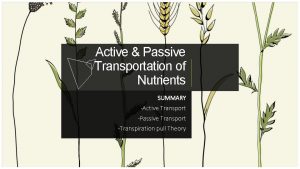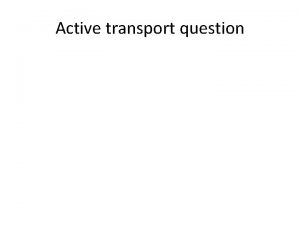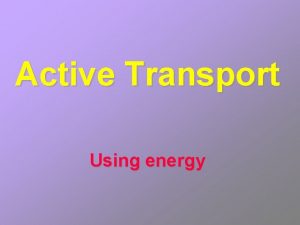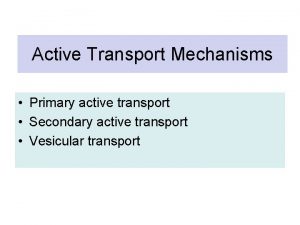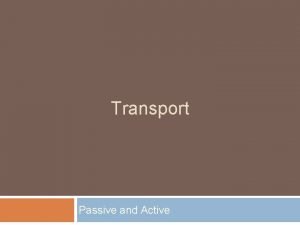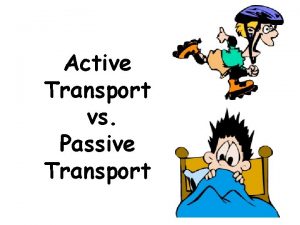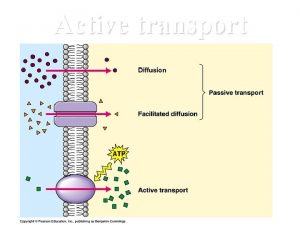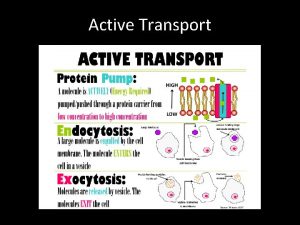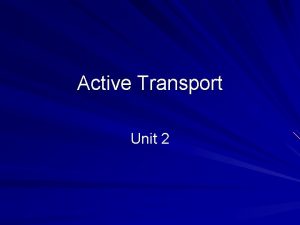Active transport question Compare the roles of active



















- Slides: 19

Active transport question

Compare the roles of active transport and diffusion across a cell membrane. (6) Carrier. Protein Channel protein Complementary Charged/large ATP – ADP + P Energy Faster Concentration gradient.

Osmosis How does water move through plasma membranes? Starter: What can you remember from GCSE? 1) Definition? 2) is it passive/active? 3) Direction of movement 4) What moves? 5) The difference between a solute, solvent & solution 6) The difference between concentrated & dilute solutions in terms of FREE water molecules

Success criteria • Explain what is meant by osmosis in terms of water potential (no calculations) • Recognise and explain the effects that solutions of different water potentials could have upon plant and animal cells.

At AS, you must call it water potential (not concentration!) Osmosis Water Potential • Diffusion of water molecules that are free to move from an area of high water potential to a low water potential through a partially permeable membrane • • • Measured in Kilopascals (k. Pa). Pure water has a water potential (WP or ) of 0 k. Pa. Whenever something is a solution in water, it will have a negative The more solute is dissolved in water, the more negative it is. (less water = more negative)

Osmosis - definition • Osmosis is the movement of water across a partially permeable membrane from a region of higher to a region of lower water potential. High osmosis lower

Which beaker contains more “free” water molecules? A beaker with exactly 150 ml pure water and 50 g sugar dissolved in it.

What happens? Draw what happens in your book.

Why does osmosis occur? High Low At high water molecules have more energy because they are less restricted by presence of solutes. At low water molecules have less energy because they are more partially permeable membrane restricted by presence of solutes.

Why does osmosis occur? more water less water High Low More water molecules can diffuse from left to right (high to low ) than from right to left. partially permeable membrane There is a net movement from high to low

Water potential • The higher the water potential the greater the energy of water molecules and the more likely they are to move by osmosis. • At standard temperature and pressure the of pure water is ZERO. • So, the addition of solutes lowers , and so makes the more negative.

In which direction will net osmosis take place? solution cell = -230 k. Pa = -150 k. Pa net osmosis Osmosis is the movement of water across a partially permeable membrane from a higher to a lower water potential.

In which directions will net osmosis take place? Cell A = -100 k. Pa Cell B = -200 k. Pa net osmosis ne os is os m os ne t sm is to Cell C = -150 k. Pa

What happens to cells in pure water? • Animal cell will eventually burst-HAEMOLYSED • Plant cells-swelling cytoplasm & vacuole will push against the cell wall which will stop the cell getting any larger-TURGID

What happens to cells in concentrated sugar solution? • Animal cell: cell contents shrink & membrane wrinkles-FLACCID • Plant cell-cytoplasm & vacuole shrink and PM pulls away from cell wall. PLASMOLYSIS

Quick Quiz 1) What is the water potential of pure water? 2) Which has more free water, -167 k. Pa or -302 k. Pa ? 3) What is the definition of osmosis? 4) Which has a higher water potential, a concentrated sugar solution or a weak sugar solution?

8 mark question • Describe how the processes of diffusion and active transport can move molecules including water, across membranes. • Marks will be given for correct use of terminology. You can use diagrams to support your answer.

Draw the table below & fill with annotated diagrams to explain what is happening… Hypotonic solution (high conc of water) Animal cells Plant cells Hypertonic solution (low conc of water) Keywords to include: q Turgid q. Flaccid q. Plasmolysis q. Water potential qk. Pa q. Solute q. Free water q Haemolysed

Complete the venn diagram
 Primary active transport and secondary active transport
Primary active transport and secondary active transport Primary active transport vs secondary active transport
Primary active transport vs secondary active transport Now answer the following questions
Now answer the following questions Passive transport vs active transport venn diagram
Passive transport vs active transport venn diagram Unlike passive transport, active transport requires
Unlike passive transport, active transport requires Bioflix activity membrane transport active transport
Bioflix activity membrane transport active transport Active transport diagram
Active transport diagram Isotonic in biology
Isotonic in biology 3 level questions
3 level questions Antiporter
Antiporter Active or passive transport
Active or passive transport Facilitated diffusion high to low
Facilitated diffusion high to low Practice types of cellular transport
Practice types of cellular transport Active transport low to high
Active transport low to high What transport is endocytosis
What transport is endocytosis 3 passive transport
3 passive transport Characteristics of active transport
Characteristics of active transport Exocytosis active or passive
Exocytosis active or passive Secondary active transport
Secondary active transport Active and passive transport
Active and passive transport











